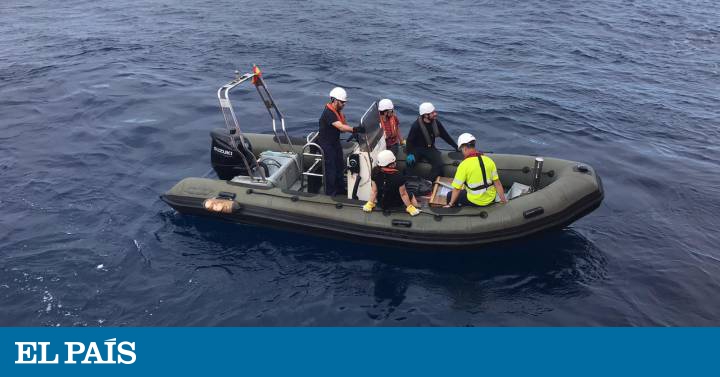It has been four weeks sailing south, aboard the
Sarmiento de Gamboa
oceanographic ship
,
hunting for emerging pollutants, those synthetic chemical compounds that may be reaching Antarctica through atmospheric and ocean currents and that we generate by many thousands kilometers.
The 17 scientists, who are from various institutions in this first oceanographic expedition of the ANTOM project, have been
relentlessly
fishing for
that garbage that is not seen, but that not only damages marine life, but ends up impacting the oceanic carbon cycle .
Still on board the
Sarmiento de Gamboa,
Jordi Dachs, from the Institute for Environmental Diagnosis and Water Studies (IDAEA), of the CSIC, recounted how from morning to night they were collecting samples of air, water and plankton, where they try to find traces of hydrocarbons, flame retardants, fertilizers ... and of course, microplastics too.
These have in common that they are the result of human action.
“The plan has been to complete this year the entire journey from Spain to Chile, from where we return, and next year to do the part of Antarctica, in the Bellingshausen Sea.
We want to understand how is the global transport of these pollutants and their impacts on the global health of the planet.
It could be that they affect phytoplankton and bacteria, making the oceans less likely to act as sinks for CO2 than is thought;
We must not forget that the Southern Ocean is considered the sink of 40% of global carbon and confirming its situation is one of the important questions we are trying to find out, ”explained Dachs.
In short, portraying a chemical footprint in our oceans that is a reflection of the lifestyle of modern societies.
Either from the same ship or from a zodiac, when time allowed, the expedition members have captured these chemical residues at depths ranging from 200 to 2,000 meters, although they also cast nets on the surface to capture the plastic fragments. .
“Even in the middle of the Atlantic, where there is nothing, we find fibers.
We have collected everything we could and then analyze it in the labs on our return.
While the expedition lasts, we don't have time ”, he acknowledged.
From Madrid, his colleague from the ANTOM project, Begoña Jiménez, from the Institute of General Organic Chemistry (IQOG-CSIC), commented that it is a very complete study in which they will analyze the compounds from a chemical, biochemical and genomic point of view, and that will expand the data already collected in the 2010 Malaespina expedition. On that occasion, as later published in
Nature Geoscience
, it was possible to determine that some of these pollutants, specifically the inflow through the atmosphere of polycyclic aromatic hydrocarbons (from of fossil fuels, fires, spills, etc.), amounted to 90,000 tons per month on the surface of the Atlantic, Pacific and Indian oceans, and that is 15% of the total carbon that is deposited.
It was "a higher figure than expected," according to Jiménez, reaching four times more than the pollution caused by the sinking of the
Deepwater Horizon
oil platform
in the Gulf of Mexico in 2010, the largest oil spill in history.
"Now we want to see how and how much of these and other emerging pollutants reaches the Southern Ocean and how they affect bacterial life, if the balance is disturbed," says the researcher.
enlarge photo Member of the ANTOM project on board the Sarmiento de Gamboa ship, with the equipment for the collection of emerging pollutants, in the recent expedition.
Jordi Dachs
Dachs, still on board the ship when the interview took place, explained that "by collecting samples throughout the entire journey through the Atlantic, it is possible to study how these compounds break up over time, something fundamental, because the models that We have the Southern Ocean as a carbon sink, they do not take this factor into account. ”“ A fundamental question is to also check the impacts of the additives in plastics, which can be more toxic than polymers, ”adds Jiménez.
Researchers from the IDAEA-CSIC participate in the ANTOM project, under the direction of Dachs and María Vila-Costa, from the University of Vigo, under the direction of Cristina Sobrino, and from the IQOG-CSIC, led by Jiménez.
A whole multidisciplinary team that reveals to us what synthetic chemical compounds do to our seas, true
dumps
of our human activity.

